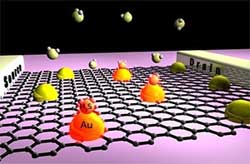Materials chemistry: As good as gold

The attachment of hydrogen sulfide gas molecules to the graphene surface results in a drop in current. Copyright : A*STAR<br>
Graphene — carbon atoms packed in a honeycomb lattice — exhibits exceptional physical and electronic properties not found in conventional materials. Decorating the surface of graphene with nanoparticles may further enhance the performance of the material, but the fabrication technique is not without its challenges.
Verawati Tjoa and co-workers at the A*STAR Singapore Institute of Manufacturing Technology and Nanyang Technological University1 have now demonstrated an easy way to decorate the surface of graphene with gold nanoparticles. The resulting material is more sensitive and versatile than undecorated graphene for gas detection.
Although high-purity graphene is obtainable through mechanical exfoliation of high-quality graphite, this method is not suitable for large-scale applications. Tjoa and her team focused their attention on reduced graphene oxide (rGO), which is much more accessible and practical for applications, and studied how attaching gold nanoparticles can affect the physical properties of the material. They obtained gold-decorated reduced graphene oxide (Au-rGO) sheets by immersing graphene oxide sheets in chloroauric acid before chemical reduction.
The formation of metal nanoparticles has actually been reported before, but as Tjoa explains “[this work] is the first of its kind to study the electronic properties of these systems”. The electrical characterization immediately shows that the Au-rGO is positively doped and has lower conductivity than rGO. The lower conductivity is likely due to the scattering of charges on the metal nanoparticles. The positive doping can be ascribed to the transfer of electrons from the graphene oxide to the metal salt during formation of the gold nanoparticles, as was confirmed through Raman spectroscopy experiments.
The researchers found interesting results when they exposed the Au-rGO layers to various gases. In the case of hydrogen sulphide, a gas that acts as an electron donor, the conductivity of Au-rGO layers showed a sharp reduction, indicating the injection of electrons to the sheet, which in turn leads to a lower number of conducting holes. This current modulation under exposure to hydrogen sulphide is significant since unmodified graphene is sensitive to oxidizing gases such as nitrogen dioxide, but not to toxic gases such as hydrogen sulphide. The sensitivity is also higher when gold nanoparticles are present, as they allow the injection of extra holes in the rGO plane, resulting in higher conductivity. The researchers also conducted additional experiments with silver-decorated rGO, yielding qualitatively similar results.
The sensitivity of the nanoparticle-decorated material can be tuned by changing the number of attached nanoparticles. “This work is the first demonstration of how the introduction of metal nanoparticles could lead to novel sensing capabilities in graphene,” says Tjoa.
The A*STAR-affiliated researchers contributing to this research are from the Singapore Institute of Manufacturing Technology
Media Contact
All latest news from the category: Materials Sciences
Materials management deals with the research, development, manufacturing and processing of raw and industrial materials. Key aspects here are biological and medical issues, which play an increasingly important role in this field.
innovations-report offers in-depth articles related to the development and application of materials and the structure and properties of new materials.
Newest articles

Machine learning algorithm reveals long-theorized glass phase in crystal
Scientists have found evidence of an elusive, glassy phase of matter that emerges when a crystal’s perfect internal pattern is disrupted. X-ray technology and machine learning converge to shed light…

Mapping plant functional diversity from space
HKU ecologists revolutionize ecosystem monitoring with novel field-satellite integration. An international team of researchers, led by Professor Jin WU from the School of Biological Sciences at The University of Hong…

Inverters with constant full load capability
…enable an increase in the performance of electric drives. Overheating components significantly limit the performance of drivetrains in electric vehicles. Inverters in particular are subject to a high thermal load,…





















